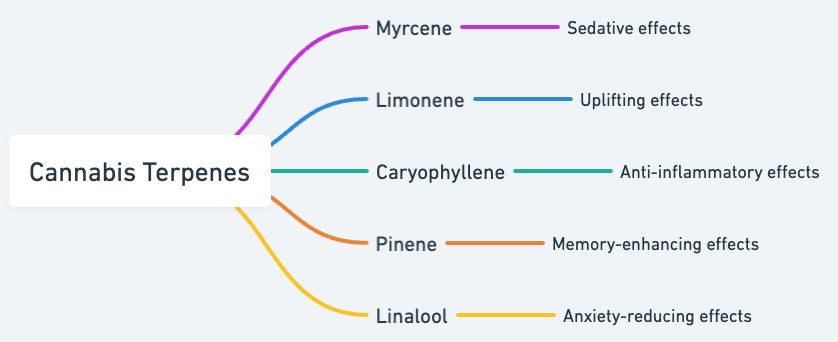
The Underestimated Power of Cannabis Terpenes
Cannabis is more than just THC and CBD. It’s a botanical powerhouse filled with hundreds of compounds, many of which have unique interactions with the human body. Among these are terpenes, the aromatic molecules that give plants—including cannabis—their characteristic scents. In this guide, we’ll delve into the often-overlooked but crucial effects of inhaling cannabis terpenes, their interaction with cannabinoids, and their potential medical applications.
What Are Terpenes?
Terpenes are organic compounds that imbue plants with their distinct aromas and flavors. In cannabis, these molecules account for the wide variety of scents and flavors among different strains—from the berry-like aromas to the pine or citrus undertones. Over 200 terpenes have been identified in cannabis, each contributing not just to its scent but also potentially to its therapeutic properties.
The “Entourage Effect”: Synergy Among Compounds
Cannabis offers a unique phenomenon called the “entourage effect.” This principle suggests that the plant’s cannabinoids and terpenes act in concert, magnifying and modulating each other’s impact. In other words, the whole plant’s effects are greater than the sum of its parts. When you inhale cannabis, you are receiving a holistic experience, courtesy of this compound synergy.
A Closer Look: Common Terpenes and Their Effects
- Myrcene: Found in mangoes, thyme, and lemongrass as well as cannabis. Known for its sedative properties, it enhances the permeability of the blood-brain barrier, speeding up the effects of cannabinoids.
- Limonene: Common in citrus fruits. It exhibits anti-anxiety, antidepressant, anti-inflammatory, and antioxidant properties.
- Pinene: Occurs in pine needles and rosemary. It can counteract some of THC’s short-term memory impacts and offers anti-inflammatory benefits.
- Linalool: Found in lavender, this terpene is known for its sedative effects, making it beneficial for people with insomnia or anxiety.
- Caryophyllene: Present in black pepper and cloves, this terpene can bind to cannabinoid receptors, potentially offering anti-inflammatory and pain-relief benefits.
Health Implications and Therapeutic Uses
Terpenes are more than just smell-good compounds; they have potential health benefits:
- Mood and Stress Relief: Terpenes like limonene and linalool could influence mood and stress levels positively.
- Pain Management: Some terpenes may amplify cannabinoids’ pain-relief properties.
- Anti-Inflammatory Effects: Terpenes such as pinene and caryophyllene have shown anti-inflammatory capabilities.
- Neuroprotective Properties: Research indicates that certain terpenes might offer neural cell protection, making them potential candidates for treating neurodegenerative diseases.
Conclusion and Future Avenues of Research
The realm of cannabis terpenes is still largely unexplored but holds considerable promise. Emerging research points to a plethora of potential health benefits, especially when terpenes interact synergistically with cannabinoids. The burgeoning field promises more personalized cannabis treatments for a range of conditions.
Note: Always consult a knowledgable healthcare provider before using cannabis for medical reasons. Individual responses can differ, so what benefits one person may not necessarily benefit another.
📗 Note: If this diagram tickled your neurons, let the book light up your synapses! Fire up “The Doctor-Approved Cannabis Handbook” through this link 📗.

Summary Notes
The Therapeutic and Sensory Impact of Inhaling Cannabis Terpenes
The inhalation of cannabis terpenes represents a significant aspect of the plant’s therapeutic and sensory appeal. Terpenes such as myrcene, limonene, pinene, and linalool offer a variety of effects, from mood enhancement and cognitive benefits to anti-inflammatory and calming properties, when inhaled. Understanding the specific impacts of these organic compounds is crucial for both medical and recreational cannabis users seeking to optimize their experience and health outcomes.
Research into the mechanisms of terpene absorption and their synergistic interactions with cannabinoids highlights the complexity of cannabis’s effects and the potential for personalized therapy approaches. Safety, dosage, and the potential side effects of terpene inhalation are critical areas of study, informing guidelines for use and minimizing risks.
As legal and regulatory frameworks evolve, so too does the need for quality control in terpene-rich cannabis products, ensuring consumers have access to safe and effective options. Advances in cannabis consumption methods aim to preserve terpene profiles, enhancing the inhalation experience and maximizing therapeutic benefits.
Educating consumers and healthcare providers about the effects of inhaled terpenes, alongside ongoing research into their health implications, will be pivotal in harnessing the full potential of cannabis terpenes. The future of terpene research promises to deepen our understanding of these aromatic compounds, paving the way for innovative applications in cannabis therapy and beyond.


